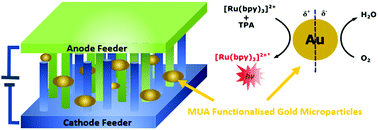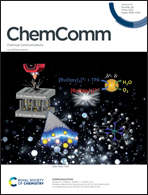Wireless electrochemiluminescence at functionalised gold microparticles using 3D titanium electrode arrays†
Abstract
Wireless electrochemiluminescence is generated using interdigitated, 3D printed, titanium arrays as feeder electrodes to shape the electric field. Gold microparticles (45 μm diameter), functionalised with 11-mercaptoundecanoic acid, act as micro-emitters to generate electrochemiluminescence from [Ru(bpy)3]2+, (bpy is 2,2′-bipyridine) where the co-reactant is tripropylamine. The oxide coated titanium allows intense electric fields, whose distribution depends on the geometry of the array, to be created in the absence of deliberately added electrolyte. COMSOL modelling and long exposure ECL imaging have been used to map the electric field distribution. Significantly, we demonstrate that by controlling the surface charge of the gold microparticles through the solution pH, the light intensity can be increased by a factor of more than 10.

- This article is part of the themed collection: Chemical Communications HOT articles


 Please wait while we load your content...
Please wait while we load your content...